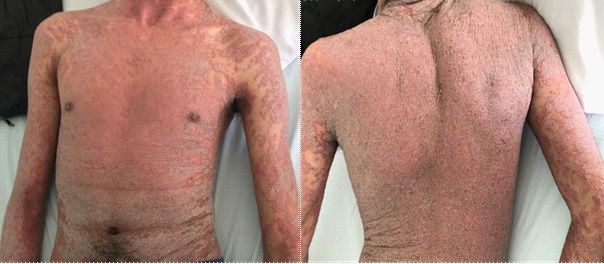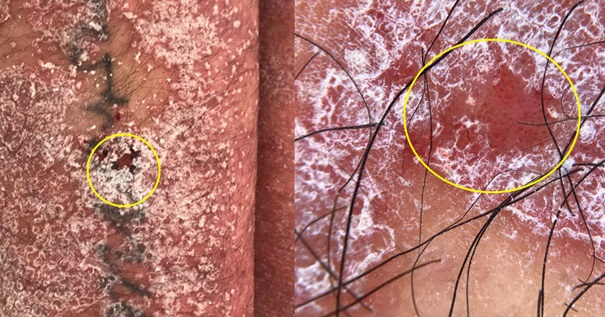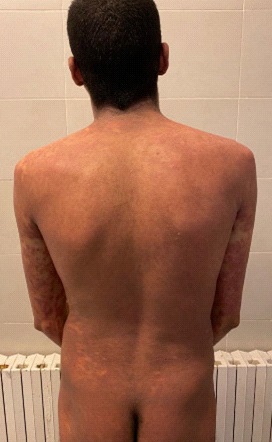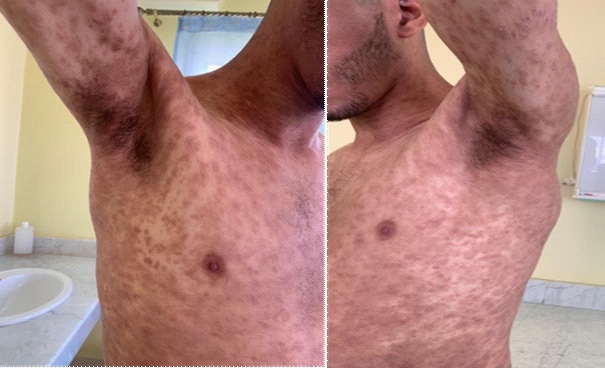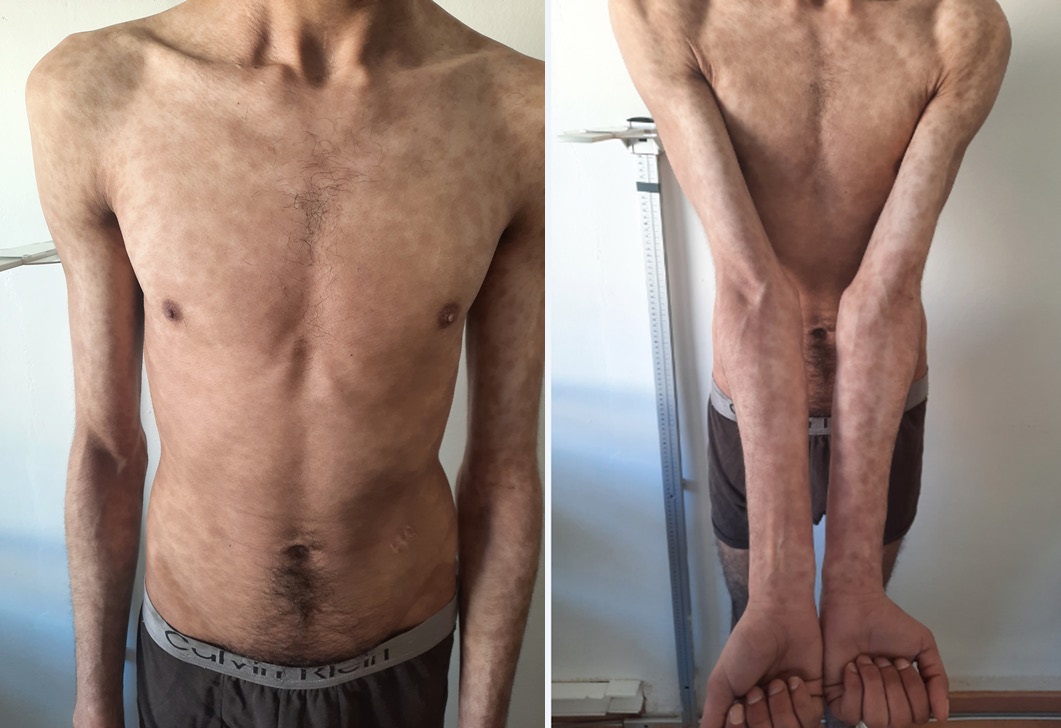
Journal of Clinical Images and Medical Case Reports
ISSN 2766-7820
Case Report - Open Access, Volume 3
Erythrodermic psoriasis revealed an HIV infection
Sara Elloudi1*; Noura Kalmi1; Salma Kadiri1; Hanane Baybay1; Zakia Douhi1; Fatima Zohra Mernissi1; Samira Rabhi2
1 Department of Dermatology, University Hospital Center Hassan II, Faculty of Medicine, University Sidi Mohammed Ben Abdellah, Fez, Morocco.
2 Department of Internal Medicine, University Hospital Center Hassan II, Faculty of Medicine, University Sidi Mohammed Ben Abdellah, Fez, Morocco.
*Corresponding Author: Sara Elloudi
University Hospital Center Hassan II, Faculty of
Medicine, University Sidi Mohammed Ben Abdellah,
Fez, Morocco.
Email: dr.elloudi@gmail.com
Received : Jan 10, 2022
Accepted : Feb 10, 2022
Published : Feb 17, 2022
Archived : www.jcimcr.org
Copyright : © Elloudi S (2022).
Abstract
Patients with psoriasis and HIV infection often present with more severe and treatment refractory cutaneous disease. We report two clinical cases in which psoriatic erythroderma revealed HIV infection, and who have responded well to antiretroviral therapy
Keywords: psoriasis; HIV infection; severe form; antiretroviral therapy.
Citation: Elloudi S, Kalmi N, Kadiri S, Baybay H, Douhi Z, et al. Erythrodermic psoriasis revealed an HIV infection. J Clin Images Med Case Rep. 2022; 3(2): 1668.
Introduction
Psoriasis is a chronic inflammatory dermatosis as common in HIV-infected patients as it is in the general population. Its prevalence is 2 to 3% [1].
Psoriasis may be the way HIV infection is found. If combined, it is more severe clinically, its severity being correlated with the level of immunosuppression. In addition, several drugs, usually used in the treatment of psoriasis, can worsen immunosuppression in the HIV-infected patient and induce interactions with other drugs, although patients generally improve with well-conducted antiviral therapy. We report two clinical cases in which psoriatic erythroderma revealed HIV infection.
Case 1
21-year-old patient with a history of unprotected sex; consulted for a non-itchy erythemato-squamous rash, of the face and scalp with rapid extension to the whole body, progressing a few months previously. The examination noted damage to the scalp and skin damage estimated at 90% without damage to the mucous membranes and without other signs of appeal, particularly articular or other. The diagnosis of psoriatic erythroderma was made and the pre-therapeutic biological assessment objectified a positive HIV serology. The patient was being treated with triple antiretroviral therapy and local corticosteroids and emollients for his psoriasis. The course was quickly favorable with complete remission with in a year.
Case 2
53-year-old patient, without notable pathological ATCD followed for psoriasis with an evolution in relapse and remission for which he was put on topical corticosteroids and methotrexate with cure then recurrence, consulted for generalization of his psoriasis. The examination noted damage to the scalp; skin involvement estimated at 80% with nail involvement.
The patient was hospitalized, a biological assessment was carried out objectifying a positive HIV serology. The patient received triple antiretroviral therapy, the course was marked by complete remission.
Discussion
Human Immunodeficiency Virus (HIV) infection is a major global epidemic. It is estimated that in 2016, 36.7 million people world wide were infected with HIV [2], Psoriasis is a prevalent systemic immune-mediated disease with cutaneous manifestations. Psoriasis has an estimated global prevalence of 2–3% of the Western population [1,3]. The prevalence of psoriasis in HIV infection does not, however, have consensus in the published literature but, it can be stated that the prevalence of psoriasis in HIV infection is at least as high as in the general population, and that this infection may be an independent risk factor for psoriatic disease. Several studies have demonstrated a relationship between the clinical severity of psoriasis and the decrease in CD4þ T-lymphocyte count in HIV infection [4,5].
Psoriasis in patients with HIV infection is characterized by a wider range of presentations, more exuberant lesions, refractory to therapy, and more frequent relapses [6]. In fact, it is sometimes the sudden change of pattern of disease in patients with psoriasis or a de novo diagnosis of this condition featuring atypical characteristics which raises the suspicion of HIV infection. It is not uncommon to see the coexistence of various forms of psoriasis in the same individual in HIV infection.
Psoriasis is considered to be the second leading cause of erythroderma in HIV-infected patients, after adverse drug reactions [7]. According to several studies including a South African study, the most common clinical form is erythrodermic [8].
Psoriasis in HIV-infected individuals is more refractory to therapy and has more frequent relapses than in noninfected patients [4,5,9]. HIV-associated psoriasis is a challenging and difficult-to-treat disease that is associated with substantial morbidity and mortality. In the HIV-infected population, treatment options are more limited and have the potential to lead to severe complications.
Treatments for patients with HIV-associated psoriasis, like all patients with psoriasis, should be based on disease severity and the risks and benefits of each medication should be considered carefully before initiation. Potential treatments include the first-line recommended agents such astopical therapy, phototherapy, and antiretrovirals, and, secondarily, theoral retinoids. For more severe, refractory disease, cautious treatment with systemic immuno suppressants such as CSA, MTX, hydroxyurea, and TNF-ainhibitors may also be considered [10]. Regardless of the therapy, patients with HIV-associated psoriasis should be followed up carefully for potential adverse events with regular monitoring of the CD4 counts and HIV viral loads, and regular consultation with an infectious disease specialist.
In our first patient, erytrodermal psoriasis was inaugural; antiretrovirals combined with topical corticosteroids and emollients led to rapid and total whitening of the psoriasis. In the second patient, the revelation of his HIV infection is caused by the aggravation of his already known psoriasis.
Conclusion
Sudden presentation of generalized psoriasis in a patient with no history of psoriasis, or worsening of the clinical form of psoriasis (extension of lesions, severe form such as erythroderma with no obvious cause) in an affected patient psoriasis should prompt the clinician to suspect immunosuppression and request HIV serology and / or viral load.
Therefore, therapy for the HIV infected patient is more challenging, requiring both careful consideration of the potential risks and benefits of treatment and more fastidious monitoring for potential adverse events.
Restoring the immune system of HIV positive patients with psoriasis alone can reduce the psoriasis lesions as was the case in our two patients.
Declarations
Acknowledgements: We are indebted to the patients, who gave us his consent for publication. We thank Professor Rabhi of the Department of internal medecine for the valuable help.
Conflict of interests statement: The authors declared no potential conflicts of interest.
Funding: The authors declare that they have no funding.
Ethical approval: The patients were informed and gave their informed consent.
Consent for publication: Written informed consent was obtained from the patients for publication of their case report and any accompanying images. A copy of the written consent is available for review by the Editor-in-Chief of this journal.
Authors contributions: All authors have contributed to this article.
References
- Neimann AL, Porter SB, Gelfand JM. The epidemiology of psoriasis. Expert Rev Dermatol. 2006; 1: 63-75.
- UNAIDS. Fact sheet – latest global and regional statistics on the status of the AIDS epidemic, http://www.unaids.org/sites/default/files/media_asset/UNAIDS_FactSheet_en.pdf (accessed 11 May 2018).
- Schafer I, Rustenbach SJ, Radtke M, et al. Epidemiologieder Psoriasis in Deutschland – Auswertungv on Sekund€ardateneinergesetzlichen Krankenversicherung. Das Gesundheitswes. 2011; 73: 308-313.
- Montazeri A, Kanitakis J, Bazex J. Psoriasis and HIV infection. Int J Dermatol. 1996; 35: 475-479.
- Mallon E, Bunker CB. HIV-associated psoriasis. AIDS Patient Care STDS. 2000; 14: 239-246.
- Fernandes S, Pinto GM, Cardoso J. Particular clinical presentations of psoriasis in HIV patients. Int J STD AIDS. 2011; 22: 653- 654.
- Garza Garza R, González González S, Ocampo Candiani J. Manifestacionescutáneasdel VIH. Gac Med Mex. 2014; 150: 194-221.
- Morar N, Willis-Owen SA, Maurer T, Bunker CB. HIV-associated psoriasis: Pathogenesis, clinical features, and management. Lancet Infect Dis. 2010; 10: 470-478.
- Bartlett BL, Khambaty M, Mendoza N, et al. Dermatological management of Human Immunodeficiency Virus (HIV). Skin Therapy Lett. 2007; 12: 1-3.
- Menon K, Van Voorhees AS, Bebo BF, et al. Psoriasis in patients with HIV infection: From the Medical Board of the National Psoriasis Foundation. J Am Acad Dermatol. 2010; 62: 291-299.

